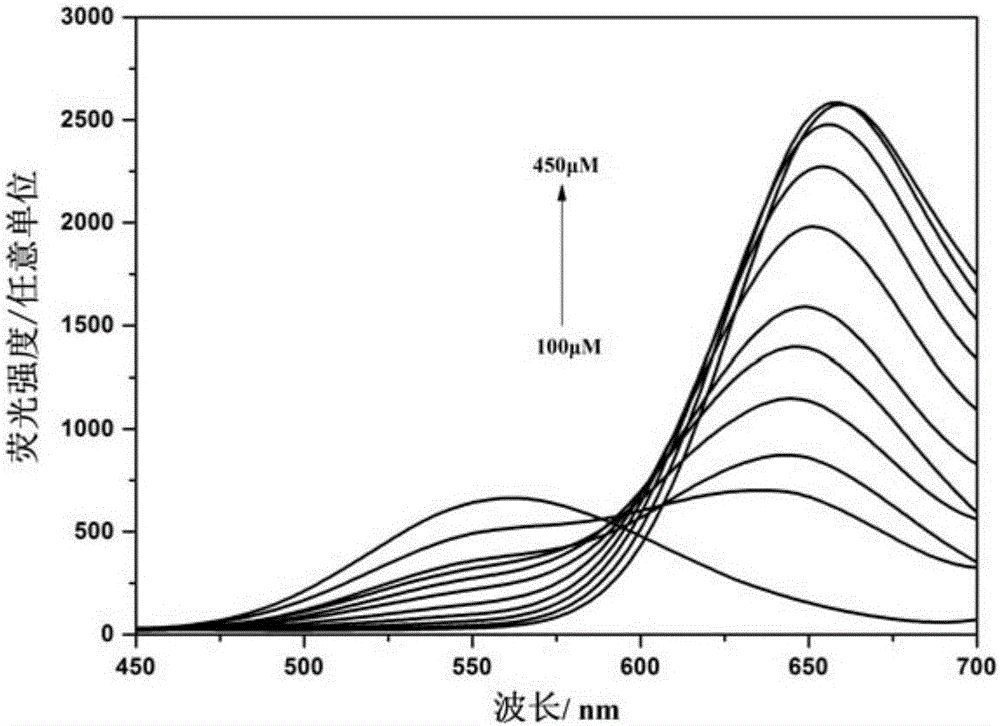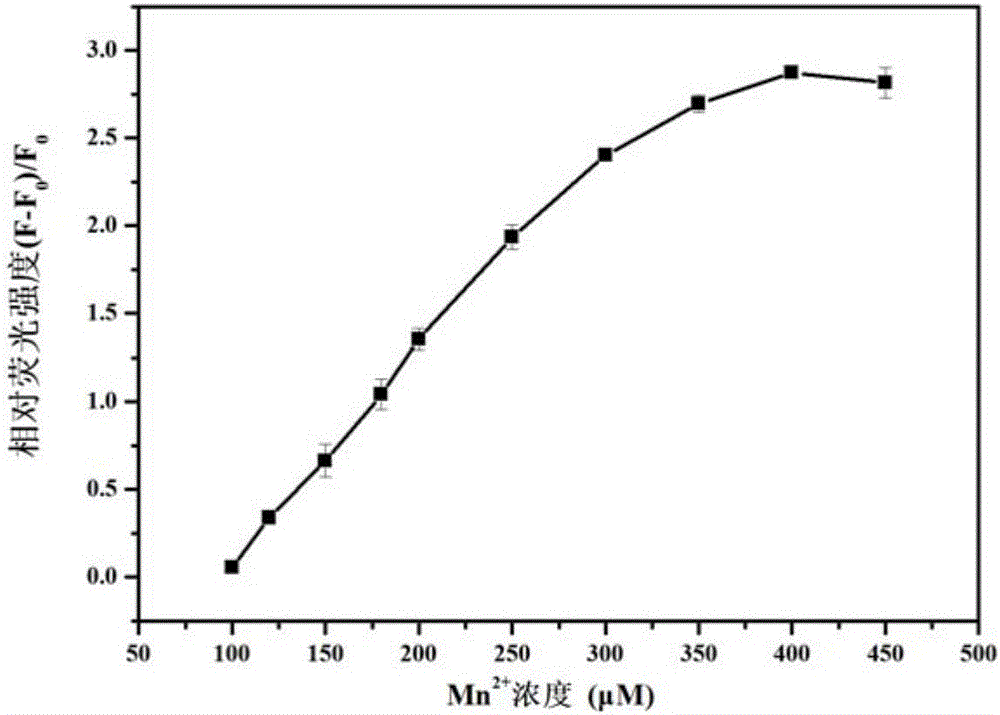Detection method of bivalent manganese ions
A technology of divalent manganese ion and detection method, applied in the field of analytical chemistry, can solve the problems of low sensitivity, poor convenience, poor water solubility, etc., and achieve the effects of good water solubility, stable signal and low toxicity
- Summary
- Abstract
- Description
- Claims
- Application Information
AI Technical Summary
Problems solved by technology
Method used
Image
Examples
Embodiment 1
[0029] A method for synthesizing fluorescent copper nano-clusters, the synthesis method is as follows: first mix 9.4 mL of 12 mM thymine solution with 100 μL of 800 mM copper sulfate solution, stir for 5 min, then add 500 μL of 800 mM hydroxylamine hydrochloride solution, and stir for 1 min , adjusted the pH to 11.5 with 10M sodium hydroxide solution, and left to react for 2 hours to obtain fluorescent copper nanoclusters.
Embodiment 2
[0031] A detection method for divalent manganese ions, the method is: respectively adding different concentrations of Mn 2+ The solution is added to the fluorescent copper nanoclusters obtained in Example 1 diluted 1-fold, so that the Mn 2+ The concentrations are 0μM, 100μM, 120μM, 150μM, 180μM, 200μM, 250μM, 300μM, 350μM, 400μM, 450μM, and the fluorescence intensity values are measured at the excitation wavelength of 354nm, and the results are shown in figure 1 , Figure 2a with Figure 2b .
[0032] Depend on figure 1 Obtain, the fluorescent copper nanocluster that embodiment 1 obtains can detect Mn sensitively 2+ , with Mn 2+ As the concentration increases, the fluorescence intensity of the fluorescent copper nanoclusters obtained in Example 1 increases gradually and the wavelength red shifts. When Mn 2+ At a concentration of 450 μM, the fluorescence of copper nanoclusters no longer increases.
[0033] Depend on Figure 2a with Figure 2b Gotta, Mn 2+ Relative...
Embodiment 3
[0035] Zn 2+ , Pb 2+ 、Cr 3+ 、Co 2+ 、Ni 2+ , Mg 2+ , Hg 2+ , Fe 3+ , Mn 2+ 、Cu 2+ , Ca 2+ Solution is added in the fluorescent copper nanocluster that the embodiment 1 of dilution 1 times obtains, makes each ion concentration be 200 μ M, measures its fluorescence intensity value respectively under 354nm excitation wavelength, calculates relative fluorescence intensity (F-F 0 ) / F 0 value, where: F 0 and F respectively represent the fluorescent intensity of the solution before and after the fluorescent copper nanoclusters obtained in Example 1 are added to the analyte, and the results are shown in image 3 .
[0036] Depend on image 3 Yes, yes Mn 2+ Response signal increases for other substances, especially for Mn 2+ The fluorescence is enhanced and the wavelength is red-shifted, which proves that the fluorescent copper nanoclusters obtained in Example 1 are paired with Mn 2+ Has high selectivity.
PUM
 Login to View More
Login to View More Abstract
Description
Claims
Application Information
 Login to View More
Login to View More - R&D
- Intellectual Property
- Life Sciences
- Materials
- Tech Scout
- Unparalleled Data Quality
- Higher Quality Content
- 60% Fewer Hallucinations
Browse by: Latest US Patents, China's latest patents, Technical Efficacy Thesaurus, Application Domain, Technology Topic, Popular Technical Reports.
© 2025 PatSnap. All rights reserved.Legal|Privacy policy|Modern Slavery Act Transparency Statement|Sitemap|About US| Contact US: help@patsnap.com



